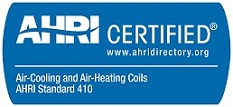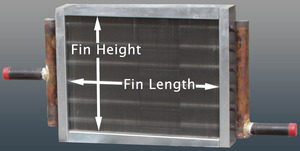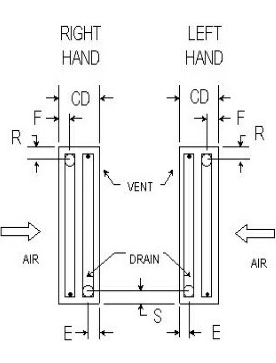If you have ever dealt with commercial HVAC coils, you have probably come across numerous “industry terms” with little to no explanation as to what these terms actually mean. To further confuse you, some verbiage is specific to the actual construction of the coil, while others are only important when determining a coil’s performance. If you do not work with coils on a frequent basis, it is hard to decipher what exactly these terms are referring to. To help translate this industry verbiage, Capital Coil & Air has come up with a list/glossary of the most common and relevant terms that you are likely to come across on most coil jobs.
Performance
- AHRI (Air-Conditioning, Heating, and Refrigeration Institute): Developed industry standards for air conditioning, heating, and commercial refrigeration equipment. All of CCA’s coils are AHRI-certified, so you know you’re getting dependable quality and performance in every product.
- Air Pressure Drop: Air Pressure Drop is a result of Flow Rate, Fin Type, Rows and Fins per Inch. In addition, on either Chilled Water or DX (Evaporator) Coils, the air pressure drop is affected by the condensate on the fin surface.
- Airflow (CFM): Cubic Feet per Minute, which refers to the amount of air flowing across the coil. A typical cooling coil should produce between 400-500 FPM. You want to avoid exceeding 550 FPM on all Chilled Water & DX Coils. Too little airflow means your coil is not running at peak capacity, while too much airflow can result in excess water carryover.
- Entering Air Dry Bulb Temperature: You guessed it! The sensible temperature of the air entering the coil.
- Leaving Air Dry Bulb Temperature: The sensible temperature of the air leaving the coil. Why does this matter? If you are trying to replace and duplicate a coil’s performance, making sure that your new coil can meet or exceed the old coil’s leaving air temperature is a crucial factor.
- Entering Air Wet Bulb Temperature: This temperature signifies the amount of moisture in the air entering the coil.
- Leaving Air Wet Bulb Temperature: Conversely, this temperature refers to the amount of moisture in the air exiting the coil.
- Total Capacity: The sum total of a coil’s sensible and latent capacities.
- Steam Pressure: Only relevant to steam coils, the saturated steam pressure at the inlet of a steam coil. Steam pressure is usually relative to the steam coil’s total capacity.
- Steam Condensate: Again, applies only to steam coils and is a measure of the condensate generated by that steam coil.
Construction
- Casing Type: The supporting metal structure for tubes and the header. Different casing options include Flanged (standard), Slip & Drive, Inverted, Stackable, and Collared End Plates & End Plates only. Steam Coils require Pitched Casing to allow for adequate condensation drainage.
- Casing Material: The coil’s casing can be made from a variety of different materials. Options include: 14 or 16 Gauge, Galvanized Steel; 304 or 316 Stainless Steel; Copper & Aluminum. Please contact us directly to see about options other than those listed.
- Connection Material And Type: Standard connection types are MPT (Male Pipe Thread, threaded on the outside), FPT (Female Pipe Thread, threaded on the inside), ODS (Sweat Connections, no threads)
- Water & Steam Coils: Copper MPT, FPT, (with options for steel MPT & FPT)
- DX & Condenser Coils: Copper ODS normally
- Circuiting/Feeds: Circuiting is determined by the number of tubes in each row divided by the total number of tubes fed (or feeds). Feeds are also known as the number of parallel circuits in the coils. Always feel free to call Capital Coil’s sales department with any circuiting-related questions.
- Water Coil: Enter the coil’s performance data into CCA’s coil selection program, and select the “auto” sizing option to determine the optimal number of feeds.
- Condenser Coil: Since the condenser is a rating program only, the user must enter a value for the number of feeds. A good rule of thumb is to have approximately 8 – 15 psi refrigerant pressure drop in the condenser.
- DX Coil: Enter coil’s performance data into CCA’s coil selection program, and select the “auto” sizing option to determine the optimal number of feeds.
- Steam: Always a full or double circuit
- Fin Height: FH is measured in the direction of the fins, or perpendicular to the direction of the tubes.

- For 5/8″ tube coils, fin heights are available in increments of 1.5”
- For 1/2″ tube coils, fin heights are available in increments of 1.25”
- For 3/8″ tube coils fins are available in 1.00″ increments
- Fin Length: FL is always measured in the direction of the tubes, regardless of which direction the tubes are running.
- Fins per Inch: Represents the fin spacing on the coil. The number of fins per inch is an essential component when ordering a replacement. Using a standard ruler, simply count the number of fins per inch on the coil.
- Number of Rows: Rows represent the coil depth and are always counted in the direction of the air flow, regardless of how the coil is mounted. Count the number of rows by viewing the header end or the return bend end of the coil.
- Chilled Water and DX Coils – 1 to 12 rows
- Hot Water Coils – 1 to 12 rows
- Steam Coils – 1 to 2 rows
- Condenser Coils – 1 to 12 rows
- Booster Coils – 1 to 12 rows
- Hand (Left or Right): A coil’s hand is determined by the direction of the airflow. Look at the finned area of the coil, and if the air is hitting you in the back of the head, look to see which side of the coil the headers are located. If the header(s) are located on the right side, then the coil is right-handed. Likewise, if the header(s) is located on the left side, it is left-handed. An important point to remember is that you always want the airflow to run counter to fluids, refrigerant and steam flow.

Miscellaneous
- Laminar Flow: Tends to occur at lower fluid velocities, below a threshold at which it becomes turbulent. In other words, laminar flow is smooth while turbulent flow is rough. Greater heat transfer occurs in a coil with turbulent flow as opposed to a calm, laminar flow.
- Dry Weight: The estimated weight of the coil; not counting internal fluids or packaging.
RELATED POSTS
Tips on Hand Designation & Counter-flow
Coils and Counter-flow: 5 Common Questions
You should never have to worry about performance on replacement coils. Well…almost never!
